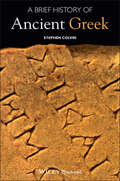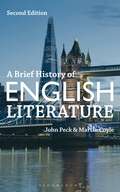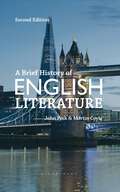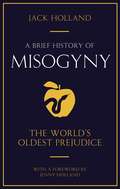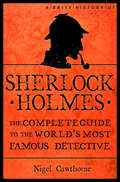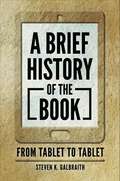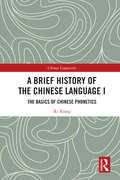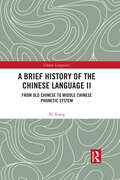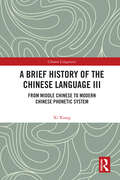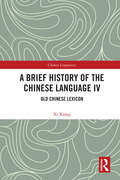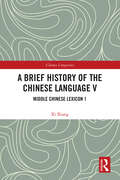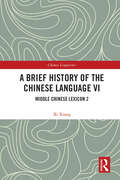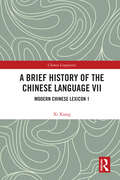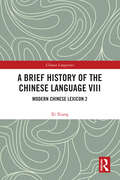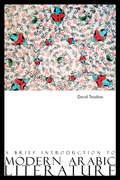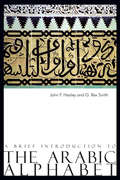- Table View
- List View
A Brief History of Ancient Greek (Wiley Brief Histories of the Ancient World)
by Stephen ColvinA Brief History of Ancient Greek accessibly depicts the social history of this ancient language from its Indo-European roots to the present day. Explains key relationships between the language and literature of the Classical period (500 - 300 BC) Provides a social history of the language which transliterates and translates all Greek as appropriate, and is therefore accessible to readers who know little or no Greek Written in the framework of modern sociolinguistic theory, relating the development of Ancient Greek to its social and political context Reflects the latest thinking on subjects such as Koiné Greek and the relationship between literary and vernacular Greek
A Brief History of Ancient Greek (Wiley Brief Histories of the Ancient World)
by Stephen ColvinA Brief History of Ancient Greek accessibly depicts the social history of this ancient language from its Indo-European roots to the present day. Explains key relationships between the language and literature of the Classical period (500 - 300 BC) Provides a social history of the language which transliterates and translates all Greek as appropriate, and is therefore accessible to readers who know little or no Greek Written in the framework of modern sociolinguistic theory, relating the development of Ancient Greek to its social and political context Reflects the latest thinking on subjects such as Koiné Greek and the relationship between literary and vernacular Greek
A Brief History of English Literature
by John Peck Martin CoyleThis new edition of an established text provides a succinct and up-to-date historical overview of the story of English literature. Focusing on how writing both reflects and challenges the periods in which it is produced, John Peck and Martin Coyle combine close readings of key texts with recent critical thinking on the interaction of literary works and culture. Providing a lively introductory guide to English literature from Beowulf to the present day, the authors write in their characteristically lucid and accessible style.A true masterpiece of clarity and compression, this is essential reading for undergraduate students coming across the vast areas of English literature for the first time and looking for a way of making critical sense of the texts being studied. In addition, the concise nature and narrative structure of this book makes it excellent reading for general readers.
A Brief History of English Literature
by John Peck Martin CoyleThis new edition of an established text provides a succinct and up-to-date historical overview of the story of English literature. Focusing on how writing both reflects and challenges the periods in which it is produced, John Peck and Martin Coyle combine close readings of key texts with recent critical thinking on the interaction of literary works and culture. Providing a lively introductory guide to English literature from Beowulf to the present day, the authors write in their characteristically lucid and accessible style.A true masterpiece of clarity and compression, this is essential reading for undergraduate students coming across the vast areas of English literature for the first time and looking for a way of making critical sense of the texts being studied. In addition, the concise nature and narrative structure of this book makes it excellent reading for general readers.New to this Edition:- Revised chapter on twentieth century literature- Complete new chapter on twenty-first century literature- Updated Chronology and Further Reading section
A Brief History of Misogyny: The World's Oldest Prejudice (Brief Histories)
by Jack HollandIn this compelling, powerful book, highly respected writer and commentator Jack Holland sets out to answer a daunting question: how do you explain the oppression and brutalization of half the world's population by the other half, throughout history? The result takes the reader on an eye-opening journey through centuries, continents and civilizations as it looks at both historical and contemporary attitudes to women. Encompassing the Church, witch hunts, sexual theory, Nazism and pro-life campaigners, we arrive at today's developing world, where women are increasingly and disproportionately at risk because of radicalised religious belief, famine, war and disease. Well-informed and researched, highly readable and thought-provoking, this is a refreshingly straightforward investigation into an ancient, pervasive and enduring injustice. It deals with the fundamentals of human existence -- sex, love, violence -- that have shaped the lives of humans throughout history. The answer? It's time to recognize that the treatment of women amounts to nothing less than an abuse of human rights on an unthinkable scale. A Brief History of Misogyny is an important and timely book that will make a long-lasting contribution to the efforts to improve those rights throughout the world.
A Brief History of Sherlock Holmes (Brief Histories)
by Nigel CawthorneCreated by Sir Arthur Conan Doyle in 1887, Sherlock Holmes appears in four novels and fifty-six short stories. Although Holmes was not the first literary detective, he continues to have a perennial allure as the ultimate sleuth. As Holmes is being re-introduced to a new audience through TV and film, Cawthorne introduces the general reader to Holmes and his creator Arthur Conan Doyle. He gives a full biography of author as well as his creation, including his resurrection following his unlikely death at the hands of arch enemy, Moriarty. Cawthorne also surveys the world of Holmes, looking at Victorian crime, the real characters behind Dr Watson and Inspector Lestrade, as well as the world on the doorstep of 22b Baker Street.
A Brief History of the Book: From Tablet to Tablet
by Steven K. GalbraithThis book leads readers through an intriguing examination of how books began and have evolved through history and explores where future technologies may lead them.From ancient clay tablet and scrolls to medieval manuscripts and printed books to personal computers and iPads, this guide examines the fascinating history of books from 4000 BCE to the present. At each step of this evolution, technologies are examined and evaluated to show how these ideas are present from the very beginning of written communication. Moving chronologically from the ancient world to the present, the book shows how written communication media evolved from cuneiform to the Kindle. Focusing on key technologies and vital periods of historical transition, it traces an evolution that elucidates the history of the written word, at each step examining and evaluating such aspects of technologies as memory capacity, readability and writability, durability, recyclability, information security, ease and mode of access, and cost. Additional attention is paid to how these technologies were made, how they were circulated, and who was reading them.
A Brief History of the Book: From Tablet to Tablet
by Steven K. GalbraithThis book leads readers through an intriguing examination of how books began and have evolved through history and explores where future technologies may lead them.From ancient clay tablet and scrolls to medieval manuscripts and printed books to personal computers and iPads, this guide examines the fascinating history of books from 4000 BCE to the present. At each step of this evolution, technologies are examined and evaluated to show how these ideas are present from the very beginning of written communication. Moving chronologically from the ancient world to the present, the book shows how written communication media evolved from cuneiform to the Kindle. Focusing on key technologies and vital periods of historical transition, it traces an evolution that elucidates the history of the written word, at each step examining and evaluating such aspects of technologies as memory capacity, readability and writability, durability, recyclability, information security, ease and mode of access, and cost. Additional attention is paid to how these technologies were made, how they were circulated, and who was reading them.
A Brief History of the Chinese Language I: The Basics of Chinese Phonetics (Chinese Linguistics)
by Xi XiangAs the first volume of a multi-volume set on Chinese phonetics, this book gives a full picture of the historical development of the Chinese language and studies the phonetics of the early form of Chinese, i.e. Old Chinese.Chinese language history is generally split into three phases: 1) Old Chinese, the form of the Chinese language spoken between the 18th century BC and the 3rd century AD, 2) Middle Chinese, between the 4th century AD to around the 12th century AD, and 3) Modern Chinese, since the 13th century. In this volume, the author first introduces basic issues in Chinese language study, including research objectives, methodology, existing scholarship, periodization, and the distinctive linguistic characteristics of each period. The core chapters then describe and analyze the phonetical systems of Old Chinese, covering the initials system and related eight aspects, two types of rhyme groups, ancient finals, and the tonal system.This comprehensive groundwork on Chinese phonetical history will be a must read for scholars and students studying Chinese language, linguistics and especially for those wishing to become acquainted with Old Chinese phonetics.
A Brief History of the Chinese Language I: The Basics of Chinese Phonetics (Chinese Linguistics)
by Xi XiangAs the first volume of a multi-volume set on Chinese phonetics, this book gives a full picture of the historical development of the Chinese language and studies the phonetics of the early form of Chinese, i.e. Old Chinese.Chinese language history is generally split into three phases: 1) Old Chinese, the form of the Chinese language spoken between the 18th century BC and the 3rd century AD, 2) Middle Chinese, between the 4th century AD to around the 12th century AD, and 3) Modern Chinese, since the 13th century. In this volume, the author first introduces basic issues in Chinese language study, including research objectives, methodology, existing scholarship, periodization, and the distinctive linguistic characteristics of each period. The core chapters then describe and analyze the phonetical systems of Old Chinese, covering the initials system and related eight aspects, two types of rhyme groups, ancient finals, and the tonal system.This comprehensive groundwork on Chinese phonetical history will be a must read for scholars and students studying Chinese language, linguistics and especially for those wishing to become acquainted with Old Chinese phonetics.
A Brief History of the Chinese Language II: From Old Chinese to Middle Chinese Phonetic System (Chinese Linguistics)
by Xi XiangAs the second volume of a multi-volume set on Chinese phonetics, this book examines the phonetical systems of Middle Chinese and phonetical changes from Old Chinese to Middle Chinese.Chinese language history is generally split into three phases: 1) Old Chinese, the form of the Chinese language spoken between the 18th century BC and the 3rd century AD, 2) Middle Chinese, between the 4th century AD to around the 12th century AD, and 3) Modern Chinese, since the 13th century. This volume studies the phonological system of Middle Chinese, including the initials system, finals system, and tonal system, examining the evolution of these systems from the period of Old Chinese to that of Middle Chinese.This comprehensive groundwork on Chinese phonetical history will be a must read for scholars and student studying Chinese language, linguistics and especially for beginning learners of Middle Chinese phonetics.
A Brief History of the Chinese Language II: From Old Chinese to Middle Chinese Phonetic System (Chinese Linguistics)
by Xi XiangAs the second volume of a multi-volume set on Chinese phonetics, this book examines the phonetical systems of Middle Chinese and phonetical changes from Old Chinese to Middle Chinese.Chinese language history is generally split into three phases: 1) Old Chinese, the form of the Chinese language spoken between the 18th century BC and the 3rd century AD, 2) Middle Chinese, between the 4th century AD to around the 12th century AD, and 3) Modern Chinese, since the 13th century. This volume studies the phonological system of Middle Chinese, including the initials system, finals system, and tonal system, examining the evolution of these systems from the period of Old Chinese to that of Middle Chinese.This comprehensive groundwork on Chinese phonetical history will be a must read for scholars and student studying Chinese language, linguistics and especially for beginning learners of Middle Chinese phonetics.
A Brief History of the Chinese Language III: From Middle Chinese to Modern Chinese Phonetic System (Chinese Linguistics)
by Xi XiangAs the third volume of a multi-volume set on Chinese phonetics, this book examines the phonetical system of Modern Chinese and phonetical changes from Middle Chinese to Modern Chinese.Chinese language history is generally split into three phases: (1) Old Chinese, the form of the Chinese language spoken between the 18th century BCE and the 3rd century CE, (2) Middle Chinese, between the 4th century AD to around the 12th century CE, and (3) Modern Chinese, since the 13th century. This volume studies the phonetical systems of Modern Chinese, including the initials system, vowel final system, nasal final system, entering final system, and tonal system. The author discusses the distinct change of these systems from the period of Middle Chinese to that of Modern Chinese and studies the formation of the standard pronunciation of the common language of the modern Han nation.This comprehensive groundwork on Chinese phonetical history will be a must read for scholars and student studying Chinese language, linguistics, and especially for beginning learners of Modern Chinese phonetics.
A Brief History of the Chinese Language III: From Middle Chinese to Modern Chinese Phonetic System (Chinese Linguistics)
by Xi XiangAs the third volume of a multi-volume set on Chinese phonetics, this book examines the phonetical system of Modern Chinese and phonetical changes from Middle Chinese to Modern Chinese.Chinese language history is generally split into three phases: (1) Old Chinese, the form of the Chinese language spoken between the 18th century BCE and the 3rd century CE, (2) Middle Chinese, between the 4th century AD to around the 12th century CE, and (3) Modern Chinese, since the 13th century. This volume studies the phonetical systems of Modern Chinese, including the initials system, vowel final system, nasal final system, entering final system, and tonal system. The author discusses the distinct change of these systems from the period of Middle Chinese to that of Modern Chinese and studies the formation of the standard pronunciation of the common language of the modern Han nation.This comprehensive groundwork on Chinese phonetical history will be a must read for scholars and student studying Chinese language, linguistics, and especially for beginning learners of Modern Chinese phonetics.
A Brief History of the Chinese Language IV: Old Chinese Lexicon (Chinese Linguistics)
by Xi XiangAs the fourth volume of a multi-volume set on the Chinese language, this book studies the lexical system of Old Chinese and the development of different types of lexicons during the period. Focusing on lexicons in Old Chinese, the early form of the Chinese language used between the 18th century BCE and the 3rd century CE, this volume first introduces the methods of word formation in Old Chinese by analyzing words inscribed in oracle bones of the Shang Dynasty. Illustrated with examples, it then examines the lexical features of Old Chinese and explores the progress and evolutionary features of monosyllabic words, polysyllabic words, lexical meanings, synonyms, and idioms and proverbs over the course of the volume.This comprehensive groundwork on Chinese lexical history is a must-read for scholars and students studying ancient Chinese language, linguistics, and especially for beginning learners of the Old Chinese lexicon.
A Brief History of the Chinese Language IV: Old Chinese Lexicon (Chinese Linguistics)
by Xi XiangAs the fourth volume of a multi-volume set on the Chinese language, this book studies the lexical system of Old Chinese and the development of different types of lexicons during the period. Focusing on lexicons in Old Chinese, the early form of the Chinese language used between the 18th century BCE and the 3rd century CE, this volume first introduces the methods of word formation in Old Chinese by analyzing words inscribed in oracle bones of the Shang Dynasty. Illustrated with examples, it then examines the lexical features of Old Chinese and explores the progress and evolutionary features of monosyllabic words, polysyllabic words, lexical meanings, synonyms, and idioms and proverbs over the course of the volume.This comprehensive groundwork on Chinese lexical history is a must-read for scholars and students studying ancient Chinese language, linguistics, and especially for beginning learners of the Old Chinese lexicon.
A Brief History of the Chinese Language V: Middle Chinese Lexicon 1 (Chinese Linguistics)
by Xi XiangAs the fifth volume of a multi-volume set on the Chinese language, this book studies the development of monosyllables and polysyllables in Middle Chinese and the overall evolution of lexical meanings during the period.Focusing on lexicons in Middle Chinese, the Chinese language used between the 4th century AD and the 12th century AD, the book first introduces the monosyllabic neologisms of Middle Chinese, including characters and words derived from Old Chinese lexicons and those newly created. It then examines the development of polysyllabic words in Middle Chinese, ranging from single morpheme words, tautologies and compound words. The final chapter discusses the changes and extension of word meanings in medieval Chinese.Illustrated with abundant examples, this comprehensive groundwork on Chinese lexical history will be a must read for scholars and students studying ancient Chinese language, linguistics and especially for beginning learners of the Middle Chinese lexicon.
A Brief History of the Chinese Language V: Middle Chinese Lexicon 1 (Chinese Linguistics)
by Xi XiangAs the fifth volume of a multi-volume set on the Chinese language, this book studies the development of monosyllables and polysyllables in Middle Chinese and the overall evolution of lexical meanings during the period.Focusing on lexicons in Middle Chinese, the Chinese language used between the 4th century AD and the 12th century AD, the book first introduces the monosyllabic neologisms of Middle Chinese, including characters and words derived from Old Chinese lexicons and those newly created. It then examines the development of polysyllabic words in Middle Chinese, ranging from single morpheme words, tautologies and compound words. The final chapter discusses the changes and extension of word meanings in medieval Chinese.Illustrated with abundant examples, this comprehensive groundwork on Chinese lexical history will be a must read for scholars and students studying ancient Chinese language, linguistics and especially for beginning learners of the Middle Chinese lexicon.
A Brief History of the Chinese Language VI: Middle Chinese Lexicon 2 (Chinese Linguistics)
by Xi XiangAs the sixth volume of a multi-volume set on the Chinese language, this book studies the influence of foreign culture on Middle Chinese lexicon and the development of synonyms, idioms and proverbs during the period.Focusing on lexicons in Middle Chinese, the middle form of the Chinese language used between the 4th century AD and the 12th century AD, this book first analyzes loanwords in Middle Chinese, a product of cultural exchange with western regions on the silk road and the impact of Buddhism. It then discusses the differences in meaning between monosyllables and polysyllables. The final chapter describes enriching idioms and proverbs and the major sources of words, including classical works, Buddhist texts and the spoken language.Illustrated with abundant examples, this comprehensive groundwork on Chinese lexical history will be a must read for scholars and students studying ancient Chinese language, linguistics and especially for beginning learners of the Middle Chinese lexicon.
A Brief History of the Chinese Language VI: Middle Chinese Lexicon 2 (Chinese Linguistics)
by Xi XiangAs the sixth volume of a multi-volume set on the Chinese language, this book studies the influence of foreign culture on Middle Chinese lexicon and the development of synonyms, idioms and proverbs during the period.Focusing on lexicons in Middle Chinese, the middle form of the Chinese language used between the 4th century AD and the 12th century AD, this book first analyzes loanwords in Middle Chinese, a product of cultural exchange with western regions on the silk road and the impact of Buddhism. It then discusses the differences in meaning between monosyllables and polysyllables. The final chapter describes enriching idioms and proverbs and the major sources of words, including classical works, Buddhist texts and the spoken language.Illustrated with abundant examples, this comprehensive groundwork on Chinese lexical history will be a must read for scholars and students studying ancient Chinese language, linguistics and especially for beginning learners of the Middle Chinese lexicon.
A Brief History of the Chinese Language VII: Modern Chinese Lexicon 1 (Chinese Linguistics)
by Xi XiangAs the seventh volume of a multi-volume set on the Chinese language, this book studies the Mongolian influence on neologisms in Modern Chinese and innovations in word formation and lexical meanings during the period.Focusing on lexicons in Modern Chinese, the Chinese language used since the 13th century CE, this book first introduces new monosyllables and the entry of spoken idioms and dialects into the written language as well as the mingling of the Chinese language with the Mongolian and Manchu languages. It then focuses on the development and features of polysyllabic words in Modern Chinese, covering alliterative and rhyming compounds and trisyllabic and four-syllable words. The final chapter discusses the change of lexical meaning systems in Modern Chinese based on an analysis of monosyllables, disyllables and polysyllables.Illustrated with abundant examples, this comprehensive groundwork on Chinese lexical history will be a must read for scholars and students studying the modern Chinese language and linguistics and especially for beginning learners of the modern Chinese lexicon.
A Brief History of the Chinese Language VIII: Modern Chinese Lexicon 2 (Chinese Linguistics)
by Xi XiangAs the final volume of a multi-volume set on the Chinese language, this book studies the Western and Japanese influence on the lexicon of Modern Chinese, lexical developments in synonyms, idioms and proverbs in modern times, and lexical developments in contemporary times.This volume first introduces the influence of foreign cultures on the modern Chinese lexicon with an emphasis on loanwords from Japanese and Indo-European languages. It then discusses the synonyms, idioms and proverbs of Modern Chinese, elucidating their evolution, sources and composition. The final part centers on the development of the Chinese lexicon after the May 4 Movement in 1919, marking the beginning of the contemporary phase of the Chinese language. The author analyses trends and types of neologisms and loanwords and analyzes the blend of Mandarin and dialect words as well as the necessity of lexical standardization.Illustrated with abundant examples, this comprehensive groundwork on Chinese lexical history will be a must read for scholars and students studying modern Chinese language, linguistics and especially for beginning learners of modern and contemporary Chinese lexicon.
A Brief History of the Chinese Language VIII: Modern Chinese Lexicon 2 (Chinese Linguistics)
by Xi XiangAs the final volume of a multi-volume set on the Chinese language, this book studies the Western and Japanese influence on the lexicon of Modern Chinese, lexical developments in synonyms, idioms and proverbs in modern times, and lexical developments in contemporary times.This volume first introduces the influence of foreign cultures on the modern Chinese lexicon with an emphasis on loanwords from Japanese and Indo-European languages. It then discusses the synonyms, idioms and proverbs of Modern Chinese, elucidating their evolution, sources and composition. The final part centers on the development of the Chinese lexicon after the May 4 Movement in 1919, marking the beginning of the contemporary phase of the Chinese language. The author analyses trends and types of neologisms and loanwords and analyzes the blend of Mandarin and dialect words as well as the necessity of lexical standardization.Illustrated with abundant examples, this comprehensive groundwork on Chinese lexical history will be a must read for scholars and students studying modern Chinese language, linguistics and especially for beginning learners of modern and contemporary Chinese lexicon.
A Brief Introduction to Modern Arabic Literature (A\brief Introduction Ser.)
by David TresilianModern Arabic literature remains little known and poorly understood despite growing curiosity among European readers. This brief introduction offers a unique overview, focusing on developments over the last fifty years. It provides a guide to the literary landscape, indicating the major landmarks in the shape of authors, ideas and debates. The picture that emerges shows that the literature of the modern Arab world, Europe's closest neighbour, is not so far from us as we are sometimes encouraged to think. A timely contribution to the dialogue between East and West, bringing modern Arabic literature into the mainstream for English-speaking readers. 'Tresilian's book is not only informative about its subject but also provides thought-provoking messages to the general reader.' -- Denys Johnson Davies Banipal
A Brief Introduction to The Arabic Alphabet
by John F. Healey G. Rex SmithThe Arabic alphabet has a rich history, one that is closely linked with the development of culture and society in the Middle East. In this comprehensive introduction the authors trace the origins of the Arabic alphabet back to Aramaic, which also gave rise to the Hebrew and Greek alphabets. Using detailed illustrations the authors investigate early Arabic papyri and early Islamic inscriptions as well as classical Arabic scripts. John F. Healey and G. Rex Smith bring the story up to the present day by examining the practice of calligraphy, printing and computing in Arabic.
